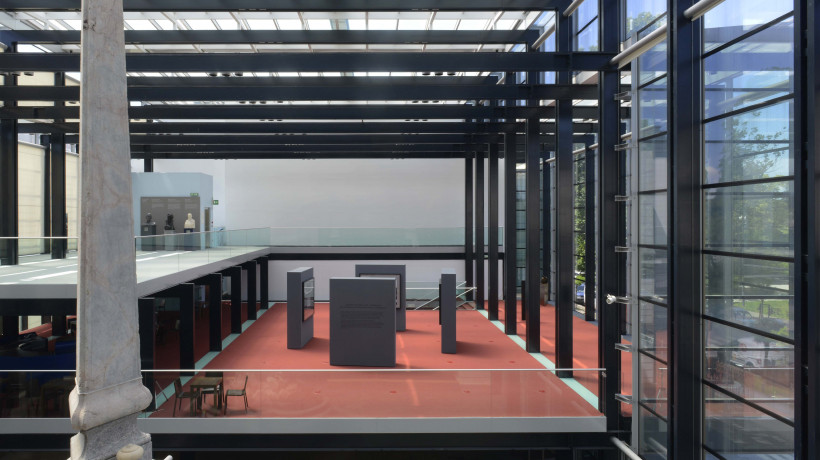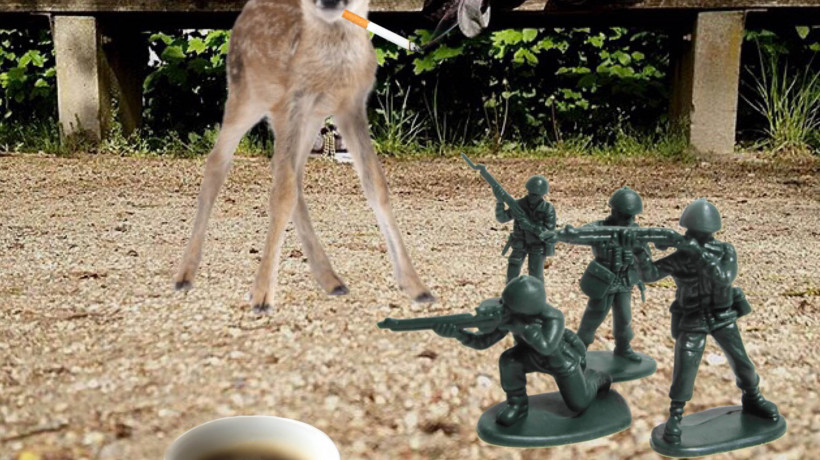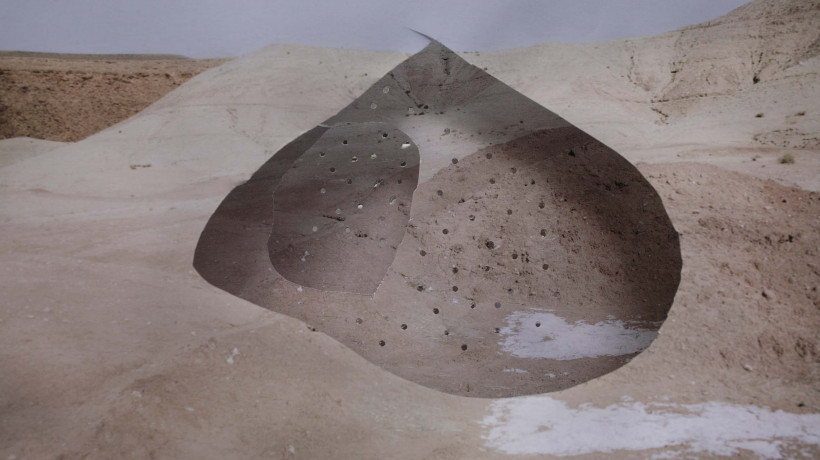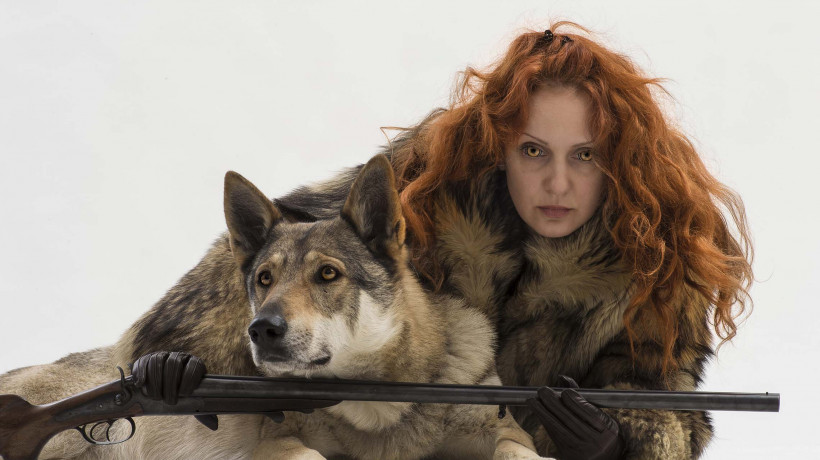Miha Colner
Miha Colner (born 1978) has graduated from Art History and works as a freelance curator and art critic. Colner works as a curator and programme coordinator at the International Centre of Graphic Arts / Svicarija Creative Centre in Ljubljana. He is also active as a publicist, specialised in photography, printmaking, artists’ moving image and various forms of (new) media art. In the period 2006-2016 he was a curator at Photon – Centre for Contemporary Photography, Ljubljana. Since 2005 he has been a contributor of newspapers, magazines, specialist publications, and his personal blog, as well as part-time lecturer. In 2006, he became a member of the project group Station DIVA at the SCCA Institute in Ljubljana, which is creating an archive and conducts research on Slovenian video art. In 2007, he co-curated and co-organized Break 2.4 festival, held biannually by K6/4 Institute. Since 2005, he has also worked as an art critic and a regular member of the cultural department at Radio Študent – he is an editor of the show on contemporary art Art-Area. He is also a regular external contributor to the daily newspaper Dnevnik and to the magazines Fotografija and Art-Words. He occasionally contributes to other specialist magazines on fine art and music, such as Maska, Forum, Časopis za kritiko znanosti, Flash, Folio, Zarez, Art Kontura, Frakcija (Croatia), Foto dokumenti (Serbia), Flaneur, Cluster (Great Britain), and Sculpture Network (USA). He lives and works in Ljubljana, Slovenia.
The author places his own decision to withdraw to the outskirts into his relationship with the world and keeps returning to his authorial treatment of various peripherals, physical or mental. Even though his works, because of their motifs, often pass into the realm of the sublime, they nevertheless very realistically discuss nature, which has, even after all the interventions during the anthropocene era, managed to withhold and survive.
Info
Bio
PDF
Close
Although the interpretations of Koštrun’s works and his entire opus are undeniably multifaceted and open to different interpretations and readings, the article suggests that all his word does share a common meditative stillness and sense of solitariness. Peter Koštrun’s opus lingers on the intersection of pristine nature and cultural landscape, on the intersection of the impact of humans on the environment and the insignificance of the individual in relation to nature. Even if Koštrun’s photographic motifs allude to archaism and romanticism, and are at first glance connected to the tradition of photographic pictorialism, they are in their essence distinctly modern, attached to the reality of the here and now. His expression is completely non-narrative in the classic sense of photographic representation, as the images do not tell a linear story, but are dedicated to visual language, which is (as opposed to the written word) always ambivalent and layered.
- Keywords: Anthropocene, landscape, melancholy, mortality, nature photography
Miha Colner (born 1978) has graduated from Art History and works as a freelance curator and art critic. Colner works as a curator and programme coordinator at the International Centre of Graphic Arts / Svicarija Creative Centre in Ljubljana. He is also active as a publicist, specialised in photography, printmaking, artists’ moving image and various forms of (new) media art. In the period 2006-2016 he was a curator at Photon – Centre for Contemporary Photography, Ljubljana. Since 2005 he has been a contributor of newspapers, magazines, specialist publications, and his personal blog, as well as part-time lecturer. In 2006, he became a member of the project group Station DIVA at the SCCA Institute in Ljubljana, which is creating an archive and conducts research on Slovenian video art. In 2007, he co-curated and co-organized Break 2.4 festival, held biannually by K6/4 Institute. Since 2005, he has also worked as an art critic and a regular member of the cultural department at Radio Študent – he is an editor of the show on contemporary art Art-Area. He is also a regular external contributor to the daily newspaper Dnevnik and to the magazines Fotografija and Art-Words. He occasionally contributes to other specialist magazines on fine art and music, such as Maska, Forum, Časopis za kritiko znanosti, Flash, Folio, Zarez, Art Kontura, Frakcija (Croatia), Foto dokumenti (Serbia), Flaneur, Cluster (Great Britain), and Sculpture Network (USA).
He lives and works in Ljubljana, Slovenia.
Peter Koštrun (1979, Ljubljana, Slovenia) graduated from Academy of Fine Arts and Design in Ljubljana, where he currently teaches at the Department of Photography. He has been exhibiting at home as well as abroad since 2003. Koštrun is a master of landscape photography known for his depiction of empty and deserted landscapes as well as his refined selection of framing and light. He is less interested in the documentary dimension of the land as he approaches the genre conceptually. His works contain a subtle atmosphere that evokes a feeling of something greateror even immortal. He lives and works in Brnica near Celje. Recent solo exhibitions include Moments, Mottard & Jenray, Liège (2012) in Belgium; The Time is Now, Photo Gallery Lang, Samobor in Crotatia (2012), Singularity, Photon Gallery in Vienna, Austra (2014) and Premonition, Center for Contemporary Arts Celje, Slovenia (2016). Koštrun has shown his work in many group exhibitions at home and abroad, including Almost Spring, 100 Years of Slovene Art at the Maribor Art Gallery (2012), as well as in one of the most important exhibitions of contemporary landscape photography, Sense of Place at the Bozar Expo in Brussels (2012), and the exhibition Land / City / Real / Imagined at Diemar / Noble Gallery in London (2011). His most recent exhibitions are After all, Cellar Gallery, Kraków, Poland (2016) and Premonition, Photon Gallery Vienna, Austria (2019). Koštrun’s works can be found in the Essl collection in Vienna and in the collection of the Cabinet of Slovenian Photography in the Museum of Gorenjska in Kranj.
Reviews in PDF format are available only to members subscribed to all PDFs ( Membrana PDF
).
DOWNLOAD PDF:
Salaj is one of those photographers who are characterized by deep reflection of the meaning and perception of image from different, mainly philosophical viewpoints, while at the same time following the objectivistic principles of photography.
Info
Bio
PDF
Close
The article that aims to analyse the artistic production of photographer Bojan Salaj is based on conversations and reviews of his archive. Among Slovenian photographers, Salaj is the one who has been seen as an embodiment of the decisive shift in perception of the photographic medium that occurred in the late 1980s and early 1990s. He has never worked as documentary photographer or photojournalist; his authorial practice has always been primarily focused on the context of exhibition and against unconventional solutions. Salaj is one of those photographers who are characterized by the deep reflection of the meaning and perception of image from different, mainly philosophical, viewpoints, while at the same time following the objectivistic principles of photography. At a glance, his practice is extremely eclectic and post-modern, which is due to the fact that he is not looking to find an individual and recognizable artistic voice; he dedicates his focus to individual projects, bringing into his work various different references and themes. Nevertheless, a central motive can still be perceived throughout his output. In the past 25 years, Salaj has mostly been attracted to the here and now; this includes the fundamental problems of representation of photography in mass media, iconography of power structures, models of construction of history, and ways of establishing national and cultural identities.
- Keywords: cultural identities, here and now, philosophy, photographer as the author, photography
Miha Colner (born 1978) has graduated from Art History and works as a freelance curator and art critic. Colner works as a curator and programme coordinator at the International Centre of Graphic Arts / Svicarija Creative Centre in Ljubljana. He is also active as a publicist, specialised in photography, printmaking, artists’ moving image and various forms of (new) media art. In the period 2006-2016 he was a curator at Photon – Centre for Contemporary Photography, Ljubljana. Since 2005 he has been a contributor of newspapers, magazines, specialist publications, and his personal blog, as well as part-time lecturer. In 2006, he became a member of the project group Station DIVA at the SCCA Institute in Ljubljana, which is creating an archive and conducts research on Slovenian video art. In 2007, he co-curated and co-organized Break 2.4 festival, held biannually by K6/4 Institute. Since 2005, he has also worked as an art critic and a regular member of the cultural department at Radio Študent – he is an editor of the show on contemporary art Art-Area. He is also a regular external contributor to the daily newspaper Dnevnik and to the magazines Fotografija and Art-Words. He occasionally contributes to other specialist magazines on fine art and music, such as Maska, Forum, Časopis za kritiko znanosti, Flash, Folio, Zarez, Art Kontura, Frakcija (Croatia), Foto dokumenti (Serbia), Flaneur, Cluster (Great Britain), and Sculpture Network (USA).
He lives and works in Ljubljana, Slovenia.
http://mihacolner.com
http://www.mglc-lj.si
Bojan Salaj (born 1964) is a photographer, who since the early 1990s continuously creates and exhibits his artistic projects. In his works he highlights and questions the representation of photography in mass media, iconography of power structures, models of construction of history, and ways of establishing national and cultural identities. He commonly follows distinctly conceptual approaches and objectivistic principles. Since 1994, he is employed as a photographer at the National Gallery in Ljubljana, and is the author of numerous photographs from the field of Slovenian fine art cultural heritage. He lives and works in Ljubljana.
Reviews in PDF format are available only to members subscribed to all PDFs ( Membrana PDF
).
DOWNLOAD PDF:
Contemporary consumerist culture reacts very positively to visual manifestations of wealth, popularity and enviable lifestyles, something which Instagram enables and promotes.
Info
Bio
PDF
Close
Contemporary consumerist culture reacts very positively to visual manifestations of wealth, popularity and enviable lifestyles, something which Instagram enables and promotes.
Miha Colner (born 1978) has graduated from Art History and works as a freelance curator and art critic. Colner works as a curator and programme coordinator at the International Centre of Graphic Arts / Svicarija Creative Centre in Ljubljana. He is also active as a publicist, specialised in photography, printmaking, artists’ moving image and various forms of (new) media art. In the period 2006-2016 he was a curator at Photon – Centre for Contemporary Photography, Ljubljana. Since 2005 he has been a contributor of newspapers, magazines, specialist publications, and his personal blog, as well as part-time lecturer. In 2006, he became a member of the project group Station DIVA at the SCCA Institute in Ljubljana, which is creating an archive and conducts research on Slovenian video art. In 2007, he co-curated and co-organized Break 2.4 festival, held biannually by K6/4 Institute. Since 2005, he has also worked as an art critic and a regular member of the cultural department at Radio Študent – he is an editor of the show on contemporary art Art-Area. He is also a regular external contributor to the daily newspaper Dnevnik and to the magazines Fotografija and Art-Words. He occasionally contributes to other specialist magazines on fine art and music, such as Maska, Forum, Časopis za kritiko znanosti, Flash, Folio, Zarez, Art Kontura, Frakcija (Croatia), Foto dokumenti (Serbia), Flaneur, Cluster (Great Britain), and Sculpture Network (USA).
He lives and works in Ljubljana, Slovenia.
Amalia Ulman (1989) is a visual artist born in Argentina. In 2011 she graduated from the Central Saint Martins College in London. In her author’s practice she addresses phenomena such as class struggle, social gender, representation of individual in mass media and on social networks, while using photos, videos, performative practices and modern communication tools, which often go beyond classical gallery practices. Ulman lives and works in Los Angeles.
Reviews in PDF format are available only to members subscribed to all PDFs ( Membrana PDF
).
DOWNLOAD PDF:
By blurring her visual identity in a public virtual space, which is almost subversive in the period of generalised extrovertedness and narcissism, Berk turns to the postulates of the dominant culture. Nevertheless, it is with this steady state of absence, during expected authenticity, that she receives a new and different type of attention from the users of social media networks.
Info
Bio
PDF
Close
By blurring her visual identity in a public virtual space, which is almost subversive in the period of generalised extrovertedness and narcissism, Berk turns to the postulates of the dominant culture. Nevertheless, it is with this steady state of absence, during expected authenticity, that she receives a new and different type of attention from the users of social media networks.
Miha Colner (born 1978) has graduated from Art History and works as a freelance curator and art critic. Colner works as a curator and programme coordinator at the International Centre of Graphic Arts / Svicarija Creative Centre in Ljubljana. He is also active as a publicist, specialised in photography, printmaking, artists’ moving image and various forms of (new) media art. In the period 2006-2016 he was a curator at Photon – Centre for Contemporary Photography, Ljubljana. Since 2005 he has been a contributor of newspapers, magazines, specialist publications, and his personal blog, as well as part-time lecturer. In 2006, he became a member of the project group Station DIVA at the SCCA Institute in Ljubljana, which is creating an archive and conducts research on Slovenian video art. In 2007, he co-curated and co-organized Break 2.4 festival, held biannually by K6/4 Institute. Since 2005, he has also worked as an art critic and a regular member of the cultural department at Radio Študent – he is an editor of the show on contemporary art Art-Area. He is also a regular external contributor to the daily newspaper Dnevnik and to the magazines Fotografija and Art-Words. He occasionally contributes to other specialist magazines on fine art and music, such as Maska, Forum, Časopis za kritiko znanosti, Flash, Folio, Zarez, Art Kontura, Frakcija (Croatia), Foto dokumenti (Serbia), Flaneur, Cluster (Great Britain), and Sculpture Network (USA).
He lives and works in Ljubljana, Slovenia.
Nataša Berk graduated from the Academy of Fine Arts in Vienna, and since 2003 she regularly creates and presents multimedia and interdisciplinary works, projects and actions ranging from performance, the adoption of identities and situations, photographs, videos, drawings to visual poetry. She lives and works in Maribor, Slovenia.
In her photographs, Bučan often depicts the commercialization of nature that is becoming a matter of culture.
Info
Bio
PDF
Close
The article analyzes the artistic process of the Berlin-based photographer Vanja Bučan, who always manages to maintain at least some recognizable expression despite her varied approaches. Her works are visually rich, carrying complex meanings and associations. She chooses not to directly reflect the collective and the individual everyday life but depicts universal existentialist motifs where the social perspective is usually shown through metaphors and allegories. The centerpiece of her work is the relationship between culture and nature and between humans and their environment, as well as the ontology of image in mass media circulation. Her photography requires a considerable degree of cerebral activity and intuition in order to sense some of the fundamental questions of humankind in the Anthropocene.
- Keywords: Anthropocene, art photography, photographic mise-en-scene, representation of nature
Miha Colner (born 1978) has graduated from Art History and works as a freelance curator and art critic. Colner works as a curator and programme coordinator at the International Centre of Graphic Arts / Svicarija Creative Centre in Ljubljana. He is also active as a publicist, specialised in photography, printmaking, artists’ moving image and various forms of (new) media art. In the period 2006-2016 he was a curator at Photon – Centre for Contemporary Photography, Ljubljana. Since 2005 he has been a contributor of newspapers, magazines, specialist publications, and his personal blog, as well as part-time lecturer. In 2006, he became a member of the project group Station DIVA at the SCCA Institute in Ljubljana, which is creating an archive and conducts research on Slovenian video art. In 2007, he co-curated and co-organized Break 2.4 festival, held biannually by K6/4 Institute. Since 2005, he has also worked as an art critic and a regular member of the cultural department at Radio Študent – he is an editor of the show on contemporary art Art-Area. He is also a regular external contributor to the daily newspaper Dnevnik and to the magazines Fotografija and Art-Words. He occasionally contributes to other specialist magazines on fine art and music, such as Maska, Forum, Časopis za kritiko znanosti, Flash, Folio, Zarez, Art Kontura, Frakcija (Croatia), Foto dokumenti (Serbia), Flaneur, Cluster (Great Britain), and Sculpture Network (USA).
He lives and works in Ljubljana, Slovenia.
Vanja Bučan (1973) is a photographer who constantly transitions between documentation driven narration and directed images. In doing so, she raises the universal issue about the relationship between humans and nature. In 2010, she graduated from the Dutch Royal Academy of Art in Deen Haag and has been working as an independent artist ever since. She actively takes part in international festivals of photography and exhibits in many institutions. She lives and works in Berlin.
Reviews in PDF format are available only to members subscribed to all PDFs ( Membrana PDF
).
DOWNLOAD PDF:
The so-called freedom of choice is turning into an infinite burden. All of this coincides with the ecologic crisis that is influencing all animal species, including humans.
Summary
Bio
PDF
Close
Maja Smrekar is a visual artist addressing current phenomena in contemporary society. Her earlier works often touch upon the mundane permeated by stereotypes of popular culture, the future as understood through fiction, and the ethical aspects of human interventions in nature and natural processes. In 2014, she began performing her continuous work K-9_topology, in which she analyses the causes and consequences of human domination on the planet, and questions the self-evidence of the anthropogenic mentality. During the following four years, this artistic research and extremely interdisciplinary action led her to deeply explore the relationship between a human and a dog. Individual elements of the project were introduced through performance, installation, artist book, and photography. The following interview focuses on this segment of her work; on her reflections on the relationship between a human and an animal; and on certain important social contexts that define her work.
- Keywords: contemporary art, human-dog relation, performance art, posthumanism, wildlife domestication
Miha Colner (born 1978) has graduated from Art History and works as a freelance curator and art critic. Colner works as a curator and programme coordinator at the International Centre of Graphic Arts / Svicarija Creative Centre in Ljubljana. He is also active as a publicist, specialised in photography, printmaking, artists’ moving image and various forms of (new) media art. In the period 2006-2016 he was a curator at Photon – Centre for Contemporary Photography, Ljubljana. Since 2005 he has been a contributor of newspapers, magazines, specialist publications, and his personal blog, as well as part-time lecturer. In 2006, he became a member of the project group Station DIVA at the SCCA Institute in Ljubljana, which is creating an archive and conducts research on Slovenian video art. In 2007, he co-curated and co-organized Break 2.4 festival, held biannually by K6/4 Institute. Since 2005, he has also worked as an art critic and a regular member of the cultural department at Radio Študent – he is an editor of the show on contemporary art Art-Area. He is also a regular external contributor to the daily newspaper Dnevnik and to the magazines Fotografija and Art-Words. He occasionally contributes to other specialist magazines on fine art and music, such as Maska, Forum, Časopis za kritiko znanosti, Flash, Folio, Zarez, Art Kontura, Frakcija (Croatia), Foto dokumenti (Serbia), Flaneur, Cluster (Great Britain), and Sculpture Network (USA). He lives and works in Ljubljana, Slovenia.
http://mihacolner.com
http://www.mglc-lj.si
Maja Smrekar (1978) graduated at the Department of Sculpture at the Academy of Fine Arts and Design in Ljubljana and holds a Master’s of Arts in Video and New Media from the same institution. Her work is based on an interdisciplinary research of the developments and application of ideological structures in society. In exhibiting her projects, she employs various art media and conceptual tools such as installation, performance, drawing, sound, text, video and photography. She has been awarded the Golden Nica award at the Ars Electronica festival and the Prešeren Foundation Award, among others. Currently, she is Guest Professor at the Department of Sculpture at the Academy of Fine Arts and Design. Maja Smrekar lives and works in Ljubljana.
PDF format files of individual interviews are priced at 6.00EUR. If you are subscribed to Membrana Online, you may purchase PDF access to all content on our site: Membrana PDF
(Online subscription is required!)
BUY PDF: M. Colner & M. Smrekar: Hybrid Family – PDF
DOWNLOAD PDF:





